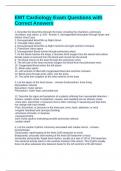EMT Cardiology Exam Questions with
Correct Answers
1. Describe the blood flow through the heart, including the chambers, pulmonary
circulation, and valves. p. 630 - Answer-1. deoxygenated blood goes through Super and
Inferior Vena Cava
2. Deoxygenated blood fills up Right Atrium
3. Tricuspid Valve opens
4. Deoxygenated blood fills up Right Ventricle and right ventricle contracts
5. Pulmonary Valve opens
6. Deoxygenated Blood travels through pulmonary artery
7. As the blood reaches the lungs, it receives fresh oxygen from the alveoli and carbon
dioxide waste is removed from the blood and moved into the alveoli
8. The blood returns to the heart through the pulmonary veins
9. The left side of the heart receives oxygen-rich blood from the pulmonary veins
10. Oxygenated Blood enters the left atrium
11. Mitral valve opens
12. Left ventricle is filled with oxygenated blood and ventricle contracts
13. Blood goes through aortic valve, into the aorta
14. The aorta then supplies all the other arteries of the body
2. List the layers of the heart tissue. - Answer-Endocardium: Inner lining
Myocardium: Muscle
Epicardium: Outer portion
Pericardium: Outer layer, pericardial sac
12. Describe the signs and symptoms of a patient suffering from myocardial infarction. -
Answer--sudden onset of weakness, nausea, and sweating w/o an obvious cause
-chest pain, discomfort, or pressure that is often crushing or squeezing and that does
not change with each breath.
-Pain, discomfort, or pressure in the lower jaw, arms, back, abdomen, or neck
-irregular heartbeat and syncope (fainting)
-shortness of breath, or dyspnea
-nausea/vomiting
-pink, frothy sputum (indicating possible pulmonary edema)
-sudden death
5. List the cardiac rhythms commonly associated with cardiac arrest. - Answer-
Dysrhythmias:
Tachycardia: rapid beating of the heart (100 beats/min or more)
Bradycardia: unusually slow beating of the heart (60 beats/min or less)
Ventricular tachycardia: Rapid heart rhythm, usually at a rate of 150 to 200 beats/min.
The electrical activity starts in the ventricle instead of the atrium. This rhythm usually
does not allow adequate time between beats for the left ventricle to fill with blood.
, Therefore, the pt's BP may fall, and the pulse ay be lost altogether. The pt may also feel
weak or light-headed or may even become unresponsive. In some cases, existing chest
pain may worsen or chest pain was not there before onset of the dysrhythmia may
develop. Most cases of ventricular tachycardia will be sustained and may deteriorate
into ventricular fibrillation
Ventricular fibrillation: (V fib)
Disorganized, ineffective quivering of the ventricles. No blood is pumped through the
body, and the patient usually becomes unconscious within seconds. The only way to
convert this dysrhythmia is to defibrillate the heart. To defibrillate means to shock the
heart with a specialized electric current in an attempt to stop the chaotic, disorganized
contraction of the myocardial cells and allow them to start again in a synchronized
manner to restore a normal rhythmic beat. Defibrillation is highly successful in terms of
saving a life if delivered within the first few minutes of sudden death. If a defibrillator is
not immediately available, CPR must be initiated until the defibrillator arrives. Even if
CPR is begun at the time of collapse, chances of survival diminish approx. 10% each
minute until defibrillation is accomplished.
8. Describe the mechanism of action, indications, side effects, and contraindications for
aspirin administration in a patient suffering from chest pain. (Cardio Chapter) p 647 -
Answer-Indications: Chest pain
Contraindications: recent stomach bleeding
-Aspirin (acetylsalicylic acid) prevents clots from forming or getting bigger.
-administer low-dose aspirin according to local protocol. Low-dose aspirin comes in 81-
mg chewable tablets. The recommended dose is 162 mg (two tablets) to 324 mg (4
tablets). be sure you have verified the pt is NOT allergic to aspirin before you give it, bc
many people are allergic.
Also ask the pt if he/she has any history of internal bleeding such as stomach ulcers,
and if so, contact medical control before giving the pt aspirin.
9. Describe the mechanism of action, indications, side effects, and contraindications for
nitroglycerine administration in a patient suffering from chest pain. (Cardio Chapter) p
648 - Answer-Relieves pain of angina
indications: chest pain of cardiac origin
contraindications: BP < 100 systolic , allergic, has taken max dose already or too soon
to administer more, presence of head injury, use of erectile dysfunction drugs
(sildenafil=viagra, tadalafil=cialis, avanafil=stendra, and vardenafil= levitra or staxyn)
w/in the previous 24-48 hours, and the maximum prescribed dose of nitroglycerin has
already been given (usually three doses)
-3 doses, 5 minutes apart
+ Nitro comes in several forms: as a small white tablet (placed sublingually = under the
tongue), as a spray(also taken sublingually), and as a skin patch applied to the chest.
[the effect is the same in any form]
-Nitroglycerin relaxes the muscle of blood vessel walls, dilates coronary arteries,
increases blood flow and the supply of oxygen to the heart muscle, and decreases the
workload of the heart. Nitroglycerin also dilates blood vessels in other parts of the body
and can sometimes cause low blood pressure and/or severe headache. Other side




